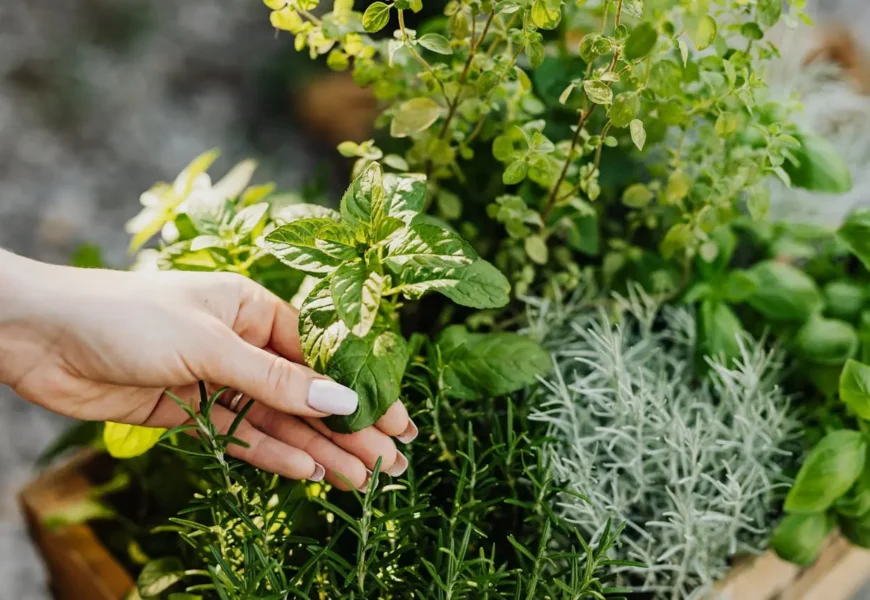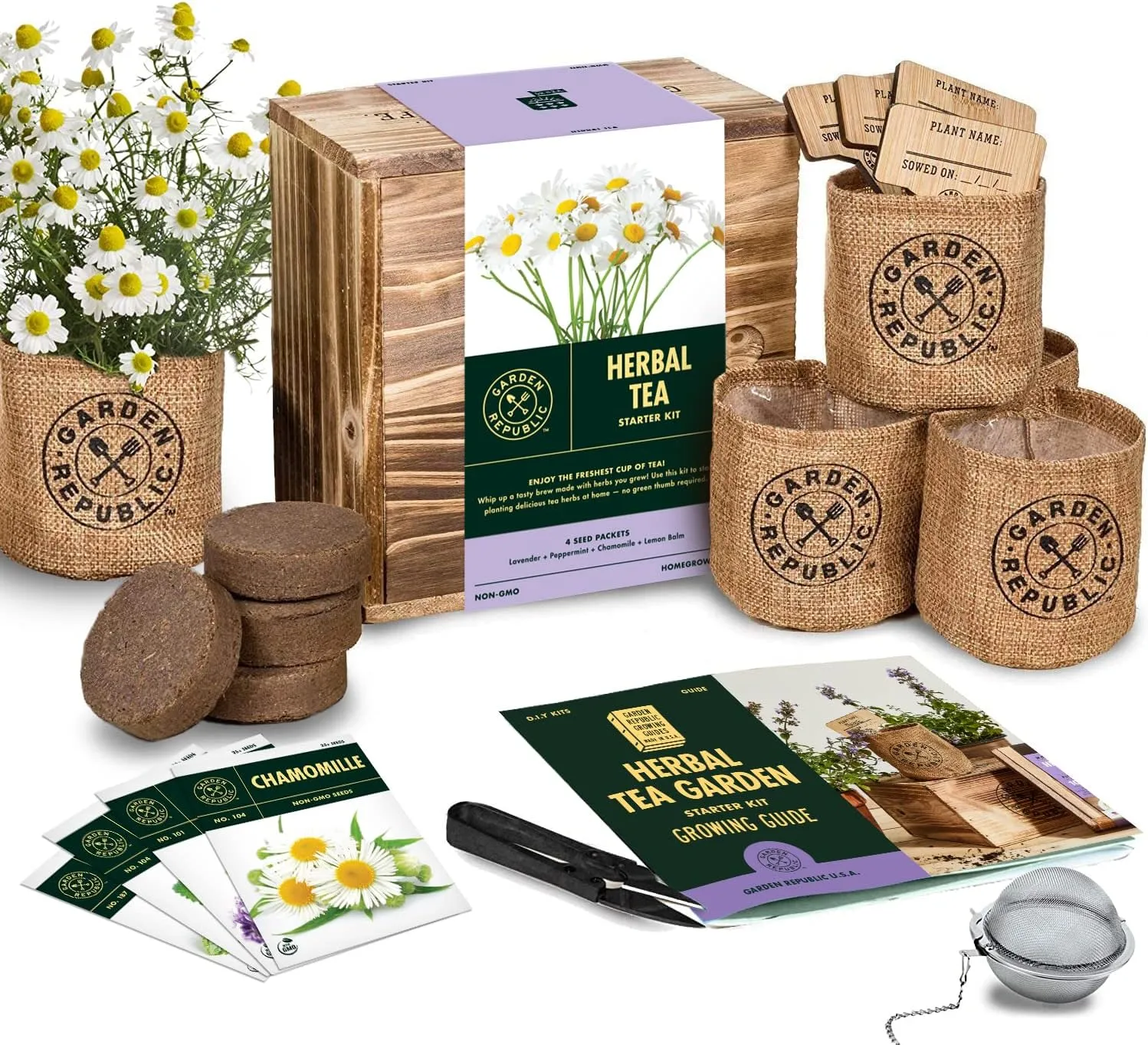In this comprehensive guide, we’ll explore everything you need to know to grow your own herbs indoor. From choosing the right herbs to setting up your garden, nurturing your plants, and enjoying the fruits of your labor, we’ve got you covered.
Table of Contents:
Let’s embark on this exciting journey of growing your own indoor herbs. Get ready to unlock the secrets of cultivating these aromatic wonders in the comfort of your home!
1. Choosing the Right Herbs
The first step in creating your indoor herb garden is selecting the right plants. Consider factors like light requirements, growth habits, and your personal taste preferences.
1. Light Requirements
Most herbs prefer bright, indirect light. While some can tolerate lower light conditions, they may not thrive as well. To assess your home’s lighting, observe the amount of natural light that enters your space throughout the day. If you have limited natural light, consider supplementing with artificial grow lights.
2. Growth Habits
Herbs vary in their growth habits. Some are compact and well-suited for containers, while others may need larger pots or even a dedicated space in your garden.
Taste Preferences:
This is where your personal touch comes in. What herbs are you most excited to grow? Do you love the peppery bite of basil, the citrusy aroma of rosemary, or the soothing properties of chamomile?
Let’s dive into some popular indoor herb choices:
1. Basil: This aromatic herb is a staple in Italian cuisine. It thrives in warm temperatures and bright indirect light.
2. Mint: A refreshing and versatile herb, mint is known for its invigorating flavor and medicinal properties. It’s easy to grow, but can be quite invasive, so be sure to choose a container with sufficient drainage.
3. Parsley: This versatile herb is essential for a range of cuisines. It prefers cool temperatures and bright indirect light.
4. Rosemary: With its piney fragrance and woody stems, rosemary is a versatile herb that adds a distinct flavor to dishes. It requires well-draining soil and ample sunlight.
5. Thyme: This aromatic herb adds a distinct flavor to savory dishes. It prefers well-draining soil and full sun.
6. Chives: These delicate herbs are related to onions and add a subtle, oniony flavor to dishes. They prefer bright, indirect light.
7. Oregano: This versatile herb is a staple in Mediterranean cuisine. It prefers well-draining soil and full sun.
8. Cilantro: This herb is beloved for its bright, fresh flavor. It prefers cool temperatures and partial shade.
9. Lemon Balm: A member of the mint family, lemon balm offers a refreshing, lemony flavor. It prefers well-draining soil and full sun.
10. Lavender: This fragrant herb is known for its calming properties and beautiful purple flowers. It prefers well-draining soil and full sun.
11. Chamomile: This herb is known for its calming properties. It prefers well-draining soil and full sun.
12. Growing tea plant indoors: A fascinating world of herbal delights awaits you! Imagine sipping a cup of tea brewed with fresh leaves from your own indoor tea garden. This is a rewarding endeavor that brings the joy of growing your own tea to your home. Learn more about growing tea plants indoors by checking out our blog post How to Grow Tea Indoors: Brew Your Own Oasis.
With so many amazing herb options to choose from, you’re bound to find the perfect additions to your indoor herb garden.
Grow Your Own Herbal Tea: Enjoy a fresh cup of tea, straight from your home garden!
This tea garden kit comes with heirloom, non-GMO Mint / Peppermint, Chamomile, Lemon Balm, and Lavender herb seeds to start your very own herb garden.
In the next section, we’ll delve into setting up the perfect home for your verdant oasis. Stay tuned!
2. Setting Up Your Indoor Garden
1. Choosing the Right Containers
When it comes to growing tea plants indoors, the right container is key. While you can certainly use traditional pots, consider getting creative! Upcycled items like vintage teacups or decorative mason jars can add a touch of personality to your indoor tea garden.
- Size Matters: Pick containers that are deep enough to accommodate your tea plant’s roots. Tea plants can grow quite large, so don’t be afraid to choose pots that are at least 12 inches in diameter.
- Drainage is Key: Make sure your containers have drainage holes to prevent root rot. Tea plants are susceptible to overwatering, so it’s essential to allow excess water to escape. You can add a layer of gravel or pebbles to the bottom of your containers to improve drainage.
- Material Matters: Terracotta pots are great for allowing excess moisture to evaporate, but they can also dry out quickly. Plastic pots can retain moisture better, which might be better suited for growing tea indoors in a drier climate.
2. Soil: The Foundation of Your Indoor Tea Garden
Using the right soil mixture is crucial for healthy tea plants. Here’s what to look for:
- Well-Draining: Tea plants thrive in well-draining soil that doesn’t get too compacted. Avoid heavy clay soils, as they can hold too much moisture.
- Nutrient-Rich: Use a potting mix formulated for herbs, as it contains the necessary nutrients to support the plant’s growth.
- pH Level: Tea plants prefer slightly acidic soil with a pH between 5.5 and 6.5. You can adjust the pH of your soil with a pH meter and amend it with lime or sulfur if necessary.
3. Light is Life for Indoor Tea Gardens
Light is essential for tea plants to grow and produce those delicious leaves. Here’s how to ensure your indoor tea garden gets enough sunshine:
- Bright, Indirect Light: Tea plants thrive in bright, indirect light. This means they need plenty of light, but not direct sunlight. A south-facing window is ideal.
- Artificial Lighting: If you don’t have enough natural light, consider supplementing with artificial grow lights. LED grow lights are highly efficient and mimic natural sunlight.
- Rotation is Key: To ensure even growth, rotate your tea plants regularly. This helps them receive light from all angles.
Don’t forget to check out these articles for more tips on growing tea indoors:
4. Planting and Care: Nurturing Your Indoor Tea Garden
Now that you’ve chosen your tea plants and set up your indoor garden, it’s time to get your hands dirty! Planting and caring for your indoor tea garden is a rewarding experience, and with a little know-how, you can enjoy fresh, homegrown tea all year round.
Planting Your Tea Plants
- Potting Mix: Start with a well-draining potting mix specifically formulated for indoor plants. Tea plants thrive in slightly acidic soil, so a mix with a pH of 5.5 to 6.5 is ideal. How to Grow Tea Indoors: Brew Your Own Oasis
- Planting Depth: When planting your tea plants, ensure the root ball is slightly above the soil line. This allows for proper drainage and prevents root rot.
- Spacing: Space your tea plants according to their mature size. If you’re growing them in a single pot, choose varieties that won’t overcrowd each other. If you have a larger space, you can give each plant ample room to grow.
- Watering: Tea plants prefer consistently moist soil, but avoid overwatering. Water thoroughly when the top inch of soil feels dry to the touch. Let the excess water drain away to prevent soggy roots.
- Sunlight: Tea plants need plenty of bright, indirect sunlight. Place them near a south-facing window or provide supplemental lighting with a grow lamp.
Maintaining Your Indoor Tea Garden
- Fertilizing: To keep your tea plants thriving, feed them with a balanced liquid fertilizer every two weeks during the growing season. You can find specialized fertilizers formulated for tea plants or use a general-purpose indoor plant fertilizer.
- Pruning: Pruning is essential for maintaining the shape and health of your tea plants. Regularly pinch back new growth to encourage bushier growth and prevent legginess.
- Pest Control: Indoor tea gardens are susceptible to pests like aphids, spider mites, and whiteflies. Monitor your plants regularly for signs of infestation. If you notice any pests, treat them promptly with a natural insecticide or horticultural oil.
- Repotting: Repot your tea plants every one to two years into a pot one size larger. This allows their roots to grow and prevents them from becoming rootbound.
Enjoying Your Indoor Tea Garden
As your tea plants grow, you’ll be able to harvest their leaves and enjoy fresh, homegrown tea. Learn How to Grow Your Own Tea Garden in Your Backyard
Remember, patience is key when growing tea indoors. Tea plants can take some time to establish themselves. However, with the right care and attention, you’ll be enjoying your own freshly brewed tea in no time
Troubleshooting and Pests: Keeping Your Indoor Herb Garden Thriving
Even the most dedicated indoor gardener can encounter challenges with pests and diseases. But don’t fret! With a little knowledge and proactive measures, you can keep your herb garden flourishing.
Common Indoor Herb Pests:
- Aphids: These tiny, soft-bodied insects often gather in clusters on leaves, sucking sap and causing stunted growth.
- Spider mites: These tiny arachnids spin webs on the undersides of leaves, causing yellowing and eventually leaf drop.
- Whiteflies: These small, white, winged insects are attracted to new growth and can quickly multiply, leading to stunted growth and sticky honeydew.
- Fungus gnats: These tiny, black flies are drawn to moist soil and can damage roots.
Dealing with Pests:
- Early Detection: Regularly inspect your plants for any signs of pests or disease, including discoloration, wilting, sticky residue, or small insects.
- Isolation: If you spot pests, isolate the affected plants to prevent infestation of the entire garden.
- Natural Remedies:
- Neem oil: A natural pesticide derived from the neem tree, it effectively controls aphids, spider mites, and whiteflies.
- Insecticidal soap: A safe and effective option for controlling aphids, mealybugs, and whiteflies.
- Diatomaceous earth: This fine powder works by dehydrating pests and can be sprinkled on the soil and plant surfaces.
- Beneficial Insects: Introducing beneficial insects like ladybugs and lacewings can help control pests naturally.
- Prevention:
- Cleanliness: Regularly wipe down your plants with a damp cloth to remove dust and debris.
- Proper Watering: Avoid overwatering as it can attract pests and create conditions for fungal diseases.
- Ventilation: Ensure good air circulation around your plants to discourage pests and disease.
Common Indoor Herb Diseases:
- Root rot: Overwatering and poor drainage can lead to root rot, causing leaves to turn yellow and wilt.
- Powdery mildew: This fungal disease appears as a white, powdery coating on leaves.
- Rust: This fungal disease causes brown or orange spots on leaves, often accompanied by yellowing and leaf drop.
Combating Disease:
- Prevention: Use sterile potting soil, avoid overwatering, and ensure good air circulation to reduce the risk of disease.
- Fungicides: For mild cases of powdery mildew, a baking soda solution can be effective. For more severe cases, use a natural fungicide like neem oil or copper spray.
Remember, prevention is key to keeping your indoor tea garden healthy. By following these tips and staying vigilant, you can ensure your herbs thrive and provide you with fresh, flavorful harvests for months to come.
If you’re interested in exploring the exciting world of growing tea plants indoors, check out our guide on how to grow tea indoors for more in-depth information and tips.
And if you’re curious about other indoor tea garden ideas, you can find inspiration in our article on cultivating your own indoor tea garden.
Conclusion:
Growing your own tea indoors offers a rewarding and fulfilling experience. It allows you to enjoy the fresh, aromatic flavors of homegrown tea year-round. From selecting the right tea plants to harvesting and enjoying your brew, this comprehensive guide provides the essential tips and techniques for a successful indoor tea garden.
Remember, with patience and care, you can create a flourishing oasis of tea plants right in your own home, providing you with a constant supply of healthy, flavorful, and satisfying tea.
Now that you know how to grow tea indoors, you can enjoy a cup of homegrown bliss anytime you want!








